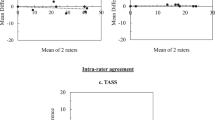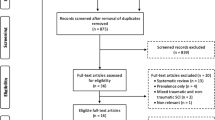Abstract
Study design:
Intra-rater reliability study, cross-sectional design.
Objectives:
To report on the intra-rater agreement of the anorectal examinations and classification of injury severity in children with spinal cord injury (SCI).
Setting:
Two, non-profit children's hospitals specializing in pediatric SCI.
Methods:
180 subjects had at least two trials of the anorectal examinations as defined by the International Standards for Neurological Classification of Spinal Cord Injury. Intraclass correlation coefficients (ICC) and 95% confidence intervals (CI) were used to evaluate the agreement. ICC>0.90=high agreement; ICC between 0.75–0.89=moderate agreement; ICC<0.75=poor agreement.
Results:
When evaluated for the entire sample, agreement was moderate-high for anal sensation and contraction and injury classification. When evaluated as a function of age at examination and type of injury, agreement for anal sensation was poor for subjects with tetraplegia in the 12–15-year age group (ICC=0.56) and 16–21-year age group (ICC=0.70) and for subjects with paraplegia in the 6–11-year age group (ICC=0.69). Agreement for anal contraction was moderate for subjects with tetraplegia in the 16–21-year age group (ICC=0.81) and subjects with paraplegia in the 12–15-year age group (ICC=0.78) and poor for subjects with paraplegia in the 6–11-year age group (ICC=0.67). Agreement for injury classification was poor for subjects with tetraplegia in the 12–15-year group (ICC=0.56) and 16–21-year group (ICC=0.74) and paraplegia in the 6–11-year group (ICC=0.11) and 12–15-year group (ICC=0.63). Anorectal responses had high agreement in subjects with tetraplegia in the 6–11-year group and moderate to high agreement in subjects with paraplegia in the 16–21-year group.
Conclusion:
The data do not fully support the use of anorectal examination in children. Further work is warranted to establish the validity of anorectal examination.
Similar content being viewed by others
Log in or create a free account to read this content
Gain free access to this article, as well as selected content from this journal and more on nature.com
or
References
American Spinal Injury Association. Reference Manual for International Standards for Neurological Classification of Spinal Cord Injury. American Spinal Injury Association: Chicago, 2003.
Marino RJ, Barros T, Biering-Sorensen F, Burns S, Donovan WH, Graves D et al. International standards for neurological classification of spinal cord injury. J Spinal Cord Med 2003; 26 (Supp 1): S50–S56.
Donovan WH, Wilkerson MA, Rossi D, Mechoulam F, Frankowsh RF . A test of the ASIA guidelines for classification of spinal cord injury. J Neuro Rehab 1990; 4: 39–53.
Ditunno JF, Donovan WH, Maynard FM . Reference Manual for the International Standards for Neurological and Functional Classification of Spinal Cord Injury. American Spinal Injury Association: Chicago, 1994.
Cohen ME, Sheehan TP, Herbison GJ . Content validity and reliability of the international standards for neurological classification of spinal cord injury. Topics SCI Rehab 1996; 1: 15–31.
Cohen ME, Ditunno JF, Donovan WH, Maynard FM . A test of the 1992 international standards for neurological and functional classification of spinal cord injury. Spinal Cord 1998; 36: 554–560.
Jonsson M, Tollback A, Gonzales H, Borg J . Inter-rater reliability of the 1992 international standards for neurological and functional classification of incomplete spinal cord injury. Spinal Cord 2000; 38: 675–679.
Marino RJ, Jones L, Kirshblum S, Tal J . Reliability of the ASIA motor and sensory examination. J Spinal Cord Med 2004; 27: 194 (Abstract).
Mulcahey MJ, Gaughan J, Betz RR, Johansen KJ . The international standards for neurological classification of spinal cord injury: reliability of data when applied to children and youths. Spinal Cord 2007; 45: 452–459.
Savic G, Bergstrom EMK, Frankel HL, Jamous MA, Jones PW . Inter-rater reliability of motor and sensory examinations performed according to American Spinal Injury Association standards. Spinal Cord 2007; 45: 444–451.
Chafetz R, Vogel L, Betz R, Gaughan JP, Mulcahey MJ . International standards for neurological classification of spinal cord injury: training effect on accurate classification. J Spinal Cord Med 2008; 31: 538–542.
Mulcahey MJ, Gaughan J, Betz R, Vogel L . Rater agreement on the ISCSCI motor and sensory scores obtained before and after formal training in testing technique. J Spinal Cord Med 2007; 30: S146–S149.
Mulcahey MJ, Gaughan J, Betz R . Agreement of repeated motor and sensory scores at individual myotomes and dermatomes in young persons with complete SCI. Spinal Cord 2009; 47: 56–61.
Conover W, Iman RL . Rank transformations as a bridge between parametric and nonparametric statistics. Am Stat 1981; 35: 124–129.
Harter HL . Expected values of normal order statistics. Biometrika 1961; 48: 151–165.
Shrout P, Fleiss JL . Intraclass correlations: uses in assessing rater reliability. Psychol Bull 1979; 86: 420–428.
Portney LG, Watkins MP . Foundations of Clinical Research. Applications to Practice. 2nd edn. Prentice Hall Health: Upper Saddle River, NJ, 2000.
Samdani A, Fayssoux R, Asghar J, McCarthy JJ, Betz R, Gaughan J, Mulcahey MJ . Chronic spinal cord injury in the pediatric population: does magnetic resonance imaging correlate with the international standards for neurological classification of spinal cord injury scores? Spine 2009; 34: 74–81.
Vogel L, DeVivo M . Pediatric spinal cord injury: etiology, demographics, and pathophysiology. Top Spinal Cord Rehab 1997; 3: 1–8.
Crozier KS, Graziani V, Ditunno JF, Herbison GJ . Spinal cord injury: prognosis for ambulation based on sensory examination in patients who are initially motor complete. Arch Phys Med Rehabil 1991; 72: 119–121.
Burns SP, Golding DG, Rolle WA, Graziani V, Ditunno JF . Recovery of ambulation in motor-incomplete tetraplegia. Arch Phys Med Rehabil 1997; 78: 1169–1172.
Marino R, Rider-Foster D, Maissel G, Ditunno JF . Superiority of motor level over single neurological level in categorizing tetraplegia. Paraplegia 1995; 33: 510–513.
Wietek BM, Baron CH, Hinnenghofen H, Badtke A, Kaps HP, Grodd W et al. Cortical processing of residual anorectal sensation in patients with spinal cord injury: an FMRI study. Neurogastroenterol Motil 2008; 20: 488–497.
Acknowledgements
This study was funded by the Shriners Hospitals for Children Research Advisory Grant no. 8956 (Mulcahey, PI). Louis Hunter, Christina Calhoun, Jennifer Schottler, Beth Lynch and Kim Curran are acknowledged for their assistance with recruitment, data collection and data management.
Author information
Authors and Affiliations
Corresponding author
Rights and permissions
About this article
Cite this article
Vogel, L., Samdani, A., Chafetz, R. et al. Intra-rater agreement of the anorectal exam and classification of injury severity in children with spinal cord injury. Spinal Cord 47, 687–691 (2009). https://doi.org/10.1038/sc.2008.180
Received:
Revised:
Accepted:
Published:
Issue date:
DOI: https://doi.org/10.1038/sc.2008.180
Keywords
This article is cited by
-
What should be clarified when learning the International Standards to Document Remaining Autonomic Function after Spinal Cord Injury (ISAFSCI) among medical students
Spinal Cord Series and Cases (2021)
-
An interview based approach to the anorectal portion of the International Standards of Neurological Classification of Spinal Cord Injury Exam (I-A-ISNCSCI): a pilot study
Spinal Cord (2020)
-
Pulse article: How do you do the international standards for neurological classification of SCI anorectal exam?
Spinal Cord Series and Cases (2017)
-
Measures and Outcome Instruments for Pediatric Spinal Cord Injury
Current Physical Medicine and Rehabilitation Reports (2016)
-
Analysis of metal artifact reduction tools for dental hardware in CT scans of the oral cavity: kVp, iterative reconstruction, dual-energy CT, metal artifact reduction software: does it make a difference?
Neuroradiology (2015)



